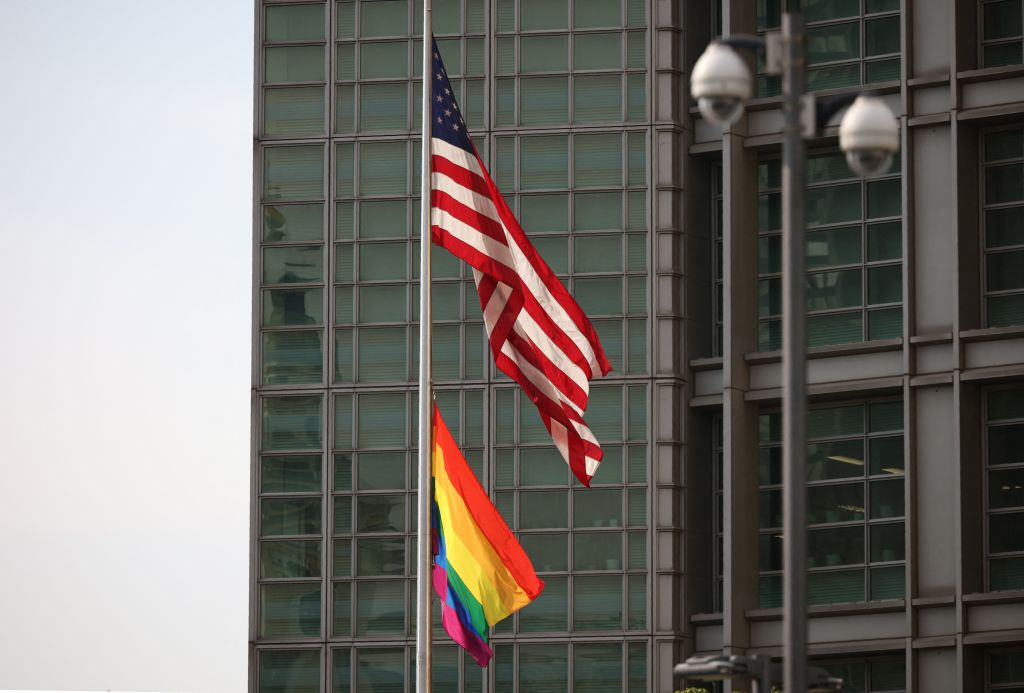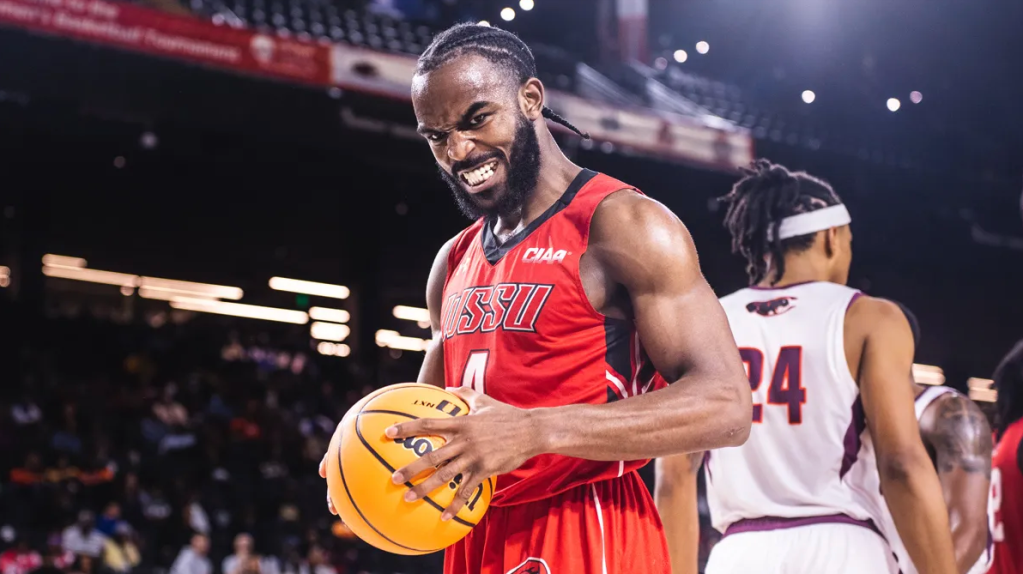
Source: DIMITAR DILKOFF / Getty
Pride Month in the United States is a time, like Black History Month, where reflection on Black Identity and the substantial work of the LGBTQIA+ culture overlap. It’s a time of remembrance: acknowledging the revolutionary counteractions against a white culture of systematic suppression that has led to the privileges indulged today: many of which were launched by Black queer and trans people.
However, in remembering, there’s also epiphany and learning. For instance, how a lot of the countercultures from the 1969 Stonewall Riots against Police Brutality to the ACT UP (AIDS Coalition to Unleash Power) movements depicted in shows like POSE used tactics that uniquely rhyme with the techniques committed by the Civil Rights Movements for the Negro population of the country. And these similarities make sense when you realize homophobia is uniquely a tool of white supremacy.
When the Americas were discovered in the earlier periods of its burglary, there were countless reports of Indigenous tribes partaking in a lot of things that Western Christians call amoral. Many nations partook in open non-monogamy and took upon the responsibility of child-rearing collectively. Many of these nations took to a system that would reflect a lot of the ideas Westerners shamed in prostitution and sex work: exchanging goods for sexual favors.
Others openly acknowledged queerness, while enforcing mating practices as an exercise in traditional family rearing. In Japan‘s Edo period, the trend of male love with Kagema or male prostitutes was frequent. Albeit, these male-to-male romances took place between younger men and older clients. All the same, the trend was linked to the culture of Kabuki theater as many Kagema were Kabuki actors. For a period, Kabuki was not only male-dominated, but illustrated only male characters, forbidding women after violent, and lawless fights broke out as johns went broke trying to maintain their paramour’s attention. These fights didn’t stop when the actors were men. If anything, they were worse.
Of course, the Europeans weren’t having any of that: so, they killed, stole, and destroyed any and all evidence they could, and still couldn’t erase the facts of human expression altogether, but could at least suppress it. It’s important to state that these histories are not queer, because they describe a time before sexuality existed. They describe a time when sexuality was an acknowledged spectrum of complex relationships where you can have a partner in marriage, but also a love with another that was so deep and emotionally permeating. These weren’t people who were queer: they were people with acts of sexuality and intimacy of ranging intensity. Many elected same-sex mates. Even more participated in same-sex acts fluidly even within marriages.
In a lot of media, homosexuality is treated like a recent surprise. Even Downtown Abbey talks about queerness like it’s a mysterious realization for people to think that like men and women might have sex, men and men and likewise can as well. Or that gender, and how we express it, is as subjective to the place you occupy. They built a history of human sexuality on a largely religious premise of the way the world works: birth into a singular pathway in life, with singular morals and singular hierarchy and a binary end to things: heaven for if you follow the single path or hell if you deviate a little. It’s a history that reminds me of how farmers herd cattle or domesticate animals to herd cattle for them: show the non-human a structured course and kill them if they leave it.
As if Europe hadn’t spearheaded the campaign against ‘sodomy’ roughly around the first yawning of White Colonization of the planet. As if we haven’t seen libraries of photos of white men visiting countries and adopting the “strange” styles of dress they discover. They go to Ireland and wear a kilt for the sensation of wearing a skirt. Men go to Dubai and wear a kurta. They wear silk Kimonos. Incorrectly, in Japan. They’ll call men who express themselves differently here in America slurs.
Likewise, people seem to treat homosexuality in the Black community in the same way. The last election was filled with discussions about how homophobic the Black Community is: allegedly more commonly than other groups. It shapes our culture as something that has been uniquely and universally outfitted to that sort of discrimination. However, just like Black culture created American culture, the truth is queer culture (Black queers in particular) helped make Black culture. Despite this, a lot of movies set in Harlem, like 2004’s BROTHER TO BROTHER, depict the violent confrontation between the conservatives of the Civil Rights Movement and the flashy libation of the Queer Harlem Society. People still debate fiercely on the sexuality of Malcolm X — particularly in the legend of his bisexual prostitution.
One of the most shocking realizations I’ve come across is the fact Homophobia in the Black Community is a relatively new phenomenon. Or new is a subjective term. Homophobia’s prevalence is as old as the global realization that White Supremacy not only exists but has become an imperial threat to cultures around the world. It makes demands of every person under its umbrella, and most often, those demands synchronize with the standard if it wants to live. That is, to assimilate to the ways of the power that we now call white supremacy, and one of those ways is to repress sexual liberation wherever it exists. And one of those ways is often homosexuality and sexual promiscuity.
By nature, white supremacy incentivizes everyone for playing in its cruelty. Those who are not at the bottom are always guaranteed someone to exploit to keep it going. It is social capitalism by another name (or at least, capitalism is financial white supremacy). This is a truth many realized around when the Irish, Italians, or the Polish sailed across the salted seas on disease-bearing ships huddled shoulder to crook like sardines in a tin, the only promise assured to many of them was if they followed the rules, they could have something.
The early 20th century became a mad grab for power for many communities, and the police were often the violent instruments of expressing who was winning the race in the eyes of white supremacy. Beats that once on limiting and controlling groups in alternating expressions of violence. They frequented many places, but none more so than Harlem, such a mecca of Black sexuality and life that no other place in the history of the U.S. was safer for a man to appear in drag. This, in part, was thanks to the sheer impact of the great migration (and the contribution of the mafia who worked alongside the Jazz and Blues).
According to historian and researcher Thaddeus Russell in his article, Color of Discipline, “Queer culture among the black working class was not limited to Harlem or to the period of the Harlem Renaissance… A variety of drag balls took place in black, working-class areas of Chicago during this period, most notably the annual Finnie’s Ball, which attracted thousands of spectators and thrived at least into the 1960s.”
Eventually, though, the only people left at the bottom of the totem pole were people of color (those damned by the government) and the sodomites (those damned by God).
Eventually, South and East Asian communities followed this system some would later describe as “the model minority” — a dangerous euphemism that allowed for the erasure of the varied problems faced by impoverished POC in America. Many Immigrants had the disadvantage of being poor and non-Anglo, but in the end, they weren’t Negroes and were married. According to Russell, this sparked two movements to race for their rung among the totem: one modeled after a group of people whose sex acts have become the categorical label they bare. Queer persons, and the Black American community.
In the same article, Russell finds that queer theorists suggested that “sexual promiscuity, the celebration of the self, the embrace of pleasure, and the avoidance of obligation—behaviors historically associated with both African Americans and homosexuals—will block the path to citizenship.”
White Supremacy was at the root of all of these feelings. There existed no reason for why merit had to be pushed towards Black Americans in a way that suggested homosexuality threatens the totality of Black American sensibilities in a culture that lauded we, as a people, exist independently of White American culture. However, White Supremacy is always insidious in its temptation. During a time of vicious Jim Crow, when Black Communities were being bombed and massacred by White people and the government, the separate but equal promise of the Emancipation Proclamation could not honestly be upheld.
In the same way that Black Elites were threatened by the rise of every community in the nation quick to obtain safety by assimilation, Black Americans were threatened by everything that might halt our community’s perception of the white gaze. Homosexuality was among the top things under scrutiny, even with many of the Black Elites moonlighting as part-time homosexuals.
The damages upon the community outweighed any fantasy of cultural independence and led to Black American’s one-hundred-year work towards assimilation into Whiteness which unfortunately included conservative values and an epitome of heteronormativity. Even known homosexuals like Countee Cullen married to fulfill these conservative obligations to our community to W.E.B. DuBois’ daughter, Yolanda, despite all noting his trouble committing to the necessities of the marriage.
Likewise, queer theorists like Andrew Sullivan cite the long fight for marriage equality as the greatest sign that queer independence has fallen to a yearning for stability. And so queerness began to adopt the culture of straight America: wealth, secrecy, and the right to equal access to the powers of the elite, including military service and same-sex marriage; white queer culture became the focus of these movements.
This doesn’t suggest that the communities individually did not continue to partake in one another. Black Queer people are everywhere in the Black Communities. Even after World War II, drag shows in Black dominated blocks had to turn away customers because of the overwhelming successes. These patrons were often members of the Black working class. Black drag performers often went home in full drag comfortably as members of a united community whereas their white counterparts returned to “normalcy” in their own neighborhoods.
What actually changed in the shift towards conservative values was the public acceptance. We adopted a language that will come to be known as homophobia and transmisogyny and soon, the language became social constructs. We removed the truth in order to keep the peace with white America and somewhere along the lines, the lie became history. Around the time race became post-racial, there began a thought that Black America does not and should not love its queerness.
That victory of white supremacy across the world is in suppression, erasure, and the illusions of isolation where there is actually legion. In the same ways it painted the illusion that Black people are inherently violent or less intelligent, it told a narrative that limited our sexual freedom and decimated our togetherness. Wherever homophobia is committed, there should be similar acknowledgement of racism within the act as there is in anti-Blackness. Albeit, that is if people can remember the truth of things.
















